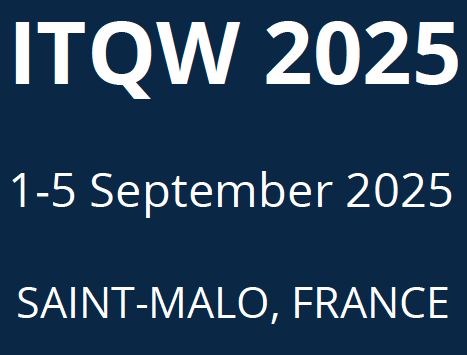SUBMISSION
Extended Abstract Submission Deadline: The deadline for abstract submission has been extended by two weeks.
The new date is 29 March 2025
INSTRUCTIONS
All abstracts must be submitted via the online platform. Abstracts sent by e-mail will not be accepted.
https://itqw2025.sciencesconf.org/
ITQW 2025 – SCOPE OF THE CONFERENCE
Mid-infrared and THz Sources, Detectors and Components
- Quantum cascade lasers, interband cascade lasers, diode lasers, nonlinear generation, frequency combs in the mid-infrared and THz spectral regions
- Quantum well infrared photodetectors (QWIPs), quantum-dot infrared photodetectors (QDIPs), quantum cascade detectors, type-II superlattice detectors, phase sensitive detection, single photon devices, novel detectors in the mid-infrared and THz spectral regions
- Heterodyne detection, novel detection schemes (plasmonic, 2D materials, antenna-coupled, nano-detectors)
- Mid-IR and THz components: ultra-fast amplitude and phase modulators, Mach-Zender modulators, high-Q resonators for Kerr dissipative combs, low loss semiconductor waveguides
- RF technologies for mid-IR and THz
Physics of intersubband related low-dimensional systems
- Physics of intersubband transitions and scattering mechanisms, and related linear and nonlinear optical properties
- Numerical modeling of intersubband physics and devices
- Novel principles for devices: metamaterials, parity-time symmetric laser systems, topological photonics
- Intersubband polaritons, ultrastrong light-matter coupling in intersubband systems, polariton lasers and condensates, intersubband plasmons
- Landau quantization, high B-field physics, superradiant emission
Mid-infrared and THz Materials
- III-V semiconductor heterostructure quantum wells including III-Nitrides and III-Sb
- Two-dimensional materials (graphene, MoS2, Black Phosphorus, etc.), bandgap engineering using Van der Waals heterostructures
- Wide bandgap, II-VI, Si/Ge for mid-IR photonics
- Zero-D and 1-D low dimensional structures (quantum dots, boxes, nanowires)
- Spintronic THz emitters and devices
- Organic systems
- Mid-IR fibers and fiber lasers
Mid-infrared and THz Applications
- Spectroscopy (sensing, heterodyne receivers, self-mixing)
- Time domain spectroscopy and sub-cycle dynamics
- Imaging (detector arrays, infrared and THz imaging, QCL-based active imaging)
- Near-field spectroscopy and imaging
- High power QCLs
- Communications (free-space laser communication, THz communications)
- Frequency metrology (QCL frequency combs, laser stabilization, ultrafast laser characterization)

